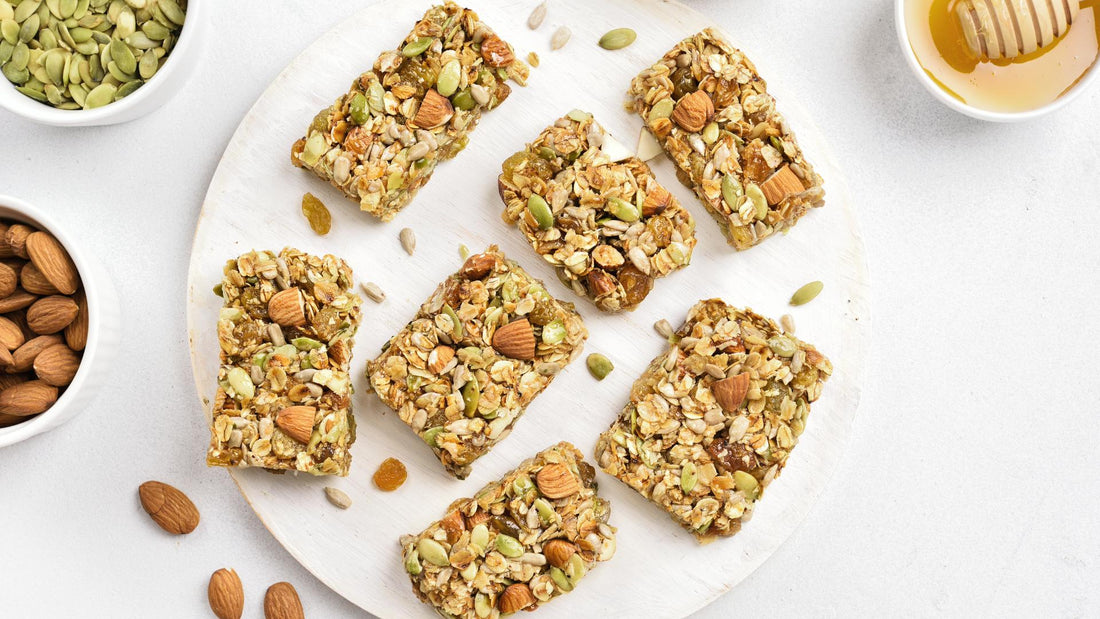
Back To School: How To Shop and Prepare Sustainable Snacks
Share
Let’s focus on sustainable and healthy food and snack choices. Studies have made us aware that food choices are crucial to our environmental footprint. As such, we aim to take a closer look at sustainable food prep and come up with suggestions and tips for you and your family.
As the summer days begin to wane and the back-to-school season approaches, it’s time to prepare for a new academic year filled with learning, growth, and midday snack cravings. We understand the convenience of reaching for pre-packaged snacks, but as you might already be aware, those are not always the healthiest options.
This year, why not take a sustainable approach to your snacking routine? By choosing snacks that are not only delicious but also eco-friendly, you can make a positive impact on both your health and the planet. In this guide, we’ll explore various back-to-school sustainable snack options that will keep you and your family energized, focused, and mindful of your environmental footprint.
We will focus on aspects of food, such as seasonality, locality and nutritiousness. Additionally, we will focus more on sustainable vegetarian options, respecting the aforementioned food characteristics, embedded in a sustainability mindset. From nutrient-packed bites to creative homemade treats, let’s embark on a snacking journey that’s good for you and the world around you.
Why Seasonality and Locality?
In the context of sustainability, seasonality refers to consuming foods that grow within their natural rhythm. They align with their natural growing cycles and local climate conditions. It involves choosing and enjoying foods that are at their peak of freshness and abundance within a particular season. This approach stands in contrast to the modern food system.
Locality refers to the practice of sourcing and consuming products that are produced within a relatively close geographical proximity to the consumer. It prioritizes goods that are cultivated, manufactured, or created within the same region or community as the consumer.

Embracing Seasonality and Locality
- Reduced Environmental Impact: Seasonal foods are typically grown closer to their point of consumption, reducing the need for long-distance transportation. This leads to lower greenhouse gas emissions associated with shipping and refrigeration.
- Preservation of Biodiversity: Choosing seasonal produce supports the cultivation of a wider variety of crops. This, in turn, helps maintain biodiversity in agriculture and preserves traditional farming practices that are often tied to specific regions and seasons.
- Support for Local Economies: When you opt for seasonal foods, you are more likely to purchase from local farmers and producers. This helps bolster local economies, encourages sustainable agricultural practices, and builds stronger connections between producers and consumers.
- Enhanced Flavor and Nutrition: Seasonal foods are harvested at their peak of ripeness, resulting in better flavour and higher nutritional content. Fruits and vegetables that have had time to fully develop on the plant tend to be richer in vitamins, minerals, and antioxidants.
- Connection to Nature: Eating seasonally fosters a deeper connection to the natural world and the rhythms of the changing seasons. It encourages an appreciation for the cycles of growth, abundance, and renewal that occur in the environment.
- Promotion of Sustainable Agriculture: Supporting seasonality often aligns with sustainable farming practices that prioritize soil health, water conservation, and reduced use of synthetic pesticides and fertilizers.
How To Adopt Seasonality and Locality
Adopting seasonality and locality into your consumption habits is a conscious and rewarding journey toward sustainability. Here’s a step-by-step outline to help you integrate these principles into your lifestyle:
Educate Yourself
We acknowledge that it can be quite chaotic to change your daily consumption behavior. Given a usually intense daily routine, it is difficult to opt for more sustainable solutions, given their potential complexity. There is a way around it though.
Take it step by step. Pick sections of your fridge and cupboards and start changing the pattern. For example, you can start with fruits and vegetables. Research the seasons and local produce in your region. Understand that fruits, vegetables, and other goods are naturally available at different times of the year. Learn about local farmers’ markets, community-supported agriculture (CSA) programs, and nearby producers.
Plan, Plan and Plan
I know what you are thinking. Every single aspect of a family’s daily life is planned. Well, so should your cooking. And believe me, it will become easier with time; it will save you time, effort and potentially money and waste. Embrace meal planning based on seasonal availability. Create a weekly or monthly meal plan that includes seasonal ingredients. Identify recipes that feature the current season’s produce as key ingredients.
Explore Farmers’ Markets and Local Shops
Get creative and explorative about your neighbourhood, city, or district. View it as a fun weekend activity. Take the whole family on a scavenger hunt for local produce. It is a great way to stay away from the faceless supermarkets and give your children and yourself a chance to close the gap between farm and fork. Visit local farmers’ markets to discover fresh, locally grown produce. Engage with farmers and ask about their growing practices. Seek out speciality stores that prioritize local and seasonal goods.
Become a Seasonal Consumer
Start implementing different habits that can change your consumer behaviour. Becoming a seasonal consumer is easier than it sounds. It’s all about combining the above-made points. Educate yourself, plan and shop accordingly. Making conscious choices while shopping stems from those three aspects. Then, you can refrain from purchasing out-of-season produce that has likely been transported from distant locations. Prioritize items that align with the current season. During peak seasons, when certain produce is abundant, consider preserving methods such as canning, freezing, or drying to enjoy them year-round.
Support Local Food Initiatives
The sustainable food movement is growing. Even in cities nowadays, there are opportunities to come in closer proximity with the food that we purchase and the people who produce it. Find and attend local food events, workshops, and gatherings that promote sustainable practices and celebrate local producers. Participate in “pick-your-own” farms or community gardens, if available. Build relationships with local farmers and producers. Ask about their practices, and show appreciation for their efforts. Participate in farm tours or open-house events to understand the journey from farm to table. It is a great way to show your support to people who are trying to close the gap between producer and consumer.
Adapt Your Cooking Style
View this change as an opportunity to become a sustainable Masterchef. Challenge yourself and your family to uncover new ways to take advantage of seasonal produce. You will be blown away by how creativity comes to the forefront when you give it a chance to shine. Adjust your cooking techniques and recipes based on seasonal ingredients. Explore new flavours and experiment with different combinations. Use seasonal produce as the foundation for your meals and build around them. But do not despair; if all fails, social media and the internet are ridden with ideas and recipes. The sustainable food movement is growing and offers many solutions to every household.
By following these steps, you’ll be well on your way to embracing a lifestyle that prioritizes seasonality and locality, contributing to a healthier, more sustainable, and more connected relationship with the food you consume and the environment you inhabit.
DIY Snacks and Refreshments
I don’t know about you, but all this talk about food got me hungry. Personally, snacks are a huge part of my day. I try to come up with creative ways to use ingredients that I have available at home, refraining from just going to the nearest store. We have gathered some ideas for snacks and refreshments that you can enjoy at home, work and school. The key point here is to avoid chemical and artificial additives and focus on more nutritious options with natural fats as well as sugars.
Below, we have outlined some sustainable DIY snacks and refreshments that not only minimize food waste but also promote plant-based diets.

Healthy snack suggestions for the whole day
- Fruit and Veggie Chips: It is a craving we all admittedly have once in a while. But why buy packaged chips when you can make delicious versions at home? You can make your own chips from fruits like apples and pears or vegetables like sweet potatoes and kale. Thinly slice, season with herbs and spices, and bake in the oven until crispy. Not only are they a healthier option, but you can customize them to your liking and experiment with different flavours and combinations.
- Homemade Granola Bars: A personal favourite. I could live on protein and granola bars. They are a great way to increase your intake of protein and fibre during the day. You can easily create your own granola bars using oats, nuts, seeds, peanut butter, tahini, dried fruits, and a natural sweetener like maple syrup. Customize them to your taste and pack them in reusable containers.
- Trail Mix: The easiest of them all, and you don’t even have to go hiking to get it. Mix together nuts, seeds, dried fruits, and perhaps some dark chocolate chips for a satisfying and portable snack. Package in reusable bags for on-the-go munching. A great source of protein and healthy fats that can keep you going and provide energy throughout the day, at school, work or at the gym.
- Vegetable Hummus Wraps: Sandwich as a school snack? That is so 90s of you. The era of wraps is here. Use tortillas, large lettuce leaves or collard greens as wraps. Fill them with homemade hummus, shredded veggies, some cheese, and your favourite plant-based protein for a refreshing and nutritious snack. It is an easy and very quick way of meal prepping for the whole family to have a nutritious and light lunch on the go.
- Green Smoothies: Smoothies are fastly becoming the go-to meal and snack. It is an easy way to fuel your body with vitamins, proteins, healthy fats and carbohydrates. Blend leafy greens with fruits, a splash of plant-based milk, and perhaps some seeds or nut butter for a nutrient-rich and delicious snack.
Snacking With a Sustainable Mindset
In conclusion, the importance of shopping locally and seasonally to create healthy snacks for school and everyday consumption cannot be overstated. By choosing to support local farmers and selecting seasonal produce, we can promote sustainability. Furthermore, reap a multitude of benefits for our health, communities, and the environment.
From an environmental perspective, choosing seasonal and local ingredients reduces the carbon footprint associated with food production and transportation. By reducing the distance our food travels to reach our plates, we decrease greenhouse gas emissions and promote sustainability, making a positive impact on our planet.
Shopping for local and seasonal foods to create healthy snacks for school is a simple yet impactful way to improve our health, support our communities, and contribute to a more sustainable and resilient food system. By making conscious choices at the grocery store, we can enjoy delicious, nutritious snacks while playing an active role in shaping a brighter, healthier future for ourselves and generations to come.

Article by Alexis Damdimopoulos. In a nutshell, I am addicted to the outdoors. I am passionate about everything surrounding food, from its production to the ethical mindset of not wasting it. I believe in a sustainable, ethical and circular mindset. Let’s meet in the GC9 blog!




